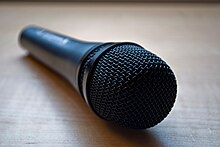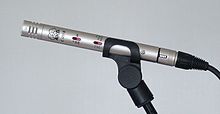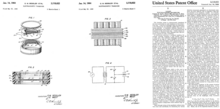MICROPHONE
 |
| Shure Brothers microphone, version 55s, Multi-Impedance "Small Unidyne" Dynamic from 1951 |
A microphone, colloquially known as a mic or mike (/maɪk/), is a device – a transducer – that converts sound into an electrical sign. Microphones are used in lots of packages inclusive of telephones, listening to aids, public deal with systems for live performance halls and public activities, movement picture production, live and recorded audio engineering, sound recording, two-manner radios, megaphones, radio and tv broadcasting. They are also utilized in computers for recording voice, speech recognition, VoIP, and for non-acoustic purposes consisting of ultrasonic sensors or knock sensors.
 |
| A Sennheiser dynamic microphone |
Several kinds of microphone are used today, which rent extraordinary strategies to transform the air strain variations of a sound wave to an electrical sign. The maximum not unusual are the dynamic microphone, which uses a coil of twine suspended in a magnetic discipline; the condenser microphone, which uses the vibrating diaphragm as a capacitor plate; and the contact microphone, which makes use of a crystal of piezoelectric fabric. Microphones normally need to be linked to a preamplifier earlier than the signal may be recorded or reproduced.
Histroy
In order to speak to larger businesses of people, a need arose to growth the volume of the human voice. The earliest devices used to obtain this have been acoustic megaphones. Some of the first examples, from 5th century BC Greece, have been theater masks with horn-fashioned mouth openings that acoustically amplified the voice of actors in amphitheaters. In 1665, the English physicist Robert Hooke became the primary to test with a medium apart from air with the discovery of the "fans' cellphone" made from stretched cord with a cup attached at each quit.
In 1861, German inventor Johann Philipp Reis constructed an early sound transmitter (the "Reis telephone") that used a steel strip attached to a vibrating membrane that could produce intermittent modern-day. Better effects had been carried out in 1876 with the "liquid transmitter" layout in early telephones from Alexander Graham Bell and Elisha Gray – the diaphragm was connected to a conductive rod in an acid solution. These structures, but, gave a very poor sound best.
 |
| David Edward Hughes invented a cartoon microphone in the 1870. |
The first microphone that enabled proper voice telephony became the (loose-touch) carbon microphone. This changed into independently evolved via David Edward Hughes in England and Emile Berliner and Thomas Edison within the US. Although Edison changed into awarded the first patent (after an extended felony dispute) in mid-1877, Hughes had tested his running device in front of many witnesses a few years earlier, and most historians credit score him with its invention. The carbon microphone is the direct prototype of latest microphones and became vital in the improvement of telephony, broadcasting and the recording industries. Thomas Edison refined the carbon microphone into his carbon-button transmitter of 1886. This microphone become employed at the first ever radio broadcast, a overall performance at the New York Metropolitan Opera House in 1910.
 |
| Humphrey Bogart, Jack Brown, and Lauren Bacall with RCA Varacoustic MI-6203 ribbon microphones in the course of World War II broadcast to troops remote places. |
In 1916, E.C. Wente of Western Electric advanced the next leap forward with the first condenser microphone. In 1923, the first sensible shifting coil microphone turned into constructed. The Marconi-Sykes magnetophone, advanced via Captain H. J. Round, have become the standard for BBC studios in London. This was progressed in 1930 with the aid of Alan Blumlein and Herbert Holman who released the HB1A and become the nice widespread of the day.
Also in 1923, the ribbon microphone become added, any other electromagnetic type, believed to have been advanced through Harry F. Olson, who basically reverse-engineered a ribbon speaker. Over the years these microphones have been evolved with the aid of several organizations, maximum drastically RCA that made big improvements in pattern manipulate, to give the microphone directionality. With tv and film generation booming there was a call for for high fidelity microphones and extra directionality. Electro-Voice answered with their Academy Award-winning shotgun microphone in 1963.
During the second 1/2 of twentieth-century improvement advanced fast with the Shure Brothers bringing out the SM58 and SM57. The latest research developments consist of the use of fibre optics, lasers and interferometers.
Components
 |
| Electronic symbol for a microphone |
The touchy transducer detail of a microphone is known as its detail or pill. Sound is first converted to mechanical motion with the aid of a diaphragm, the motion of which is then converted to an electrical signal. A whole microphone also includes a housing, some means of bringing the sign from the detail to different system, and regularly an digital circuit to conform the output of the pill to the device being driven. A wireless microphone consists of a radio transmitter.
Varieties
Microphones are categorized by using their transducer principle, which include condenser, dynamic, and so on., and by means of their directional traits. Sometimes other characteristics which include diaphragm size, supposed use or orientation of the essential sound input to the predominant axis (stop- or facet-address) of the microphone are used to describe the microphone.
Condeser
 |
| Inside the Oktava 319 condenser microphone |
The condenser microphone, invented at Western Electric in 1916 with the aid of E. C. Wente, is likewise referred to as a capacitor microphone or electrostatic microphone—capacitors had been historically known as condensers. Here, the diaphragm acts as one plate of a capacitor, and the vibrations produce adjustments inside the distance between the plates. There are two types, depending at the technique of extracting the audio sign from the transducer: DC-biased microphones, and radio frequency (RF) or high frequency (HF) condenser microphones. With a DC-biased microphone, the plates are biased with a fixed charge (Q). The voltage maintained across the capacitor plates adjustments with the vibrations in the air, according to the capacitance equation (C = Q⁄V), wherein Q = fee in coulombs, C = capacitance in farads and V = capacity difference in volts. The capacitance of the plates is inversely proportional to the gap among them for a parallel-plate capacitor. The assembly of constant and movable plates is called an "detail" or "capsule".
A nearly consistent charge is maintained at the capacitor. As the capacitance changes, the charge across the capacitor does trade very barely, but at audible frequencies it's far sensibly constant. The capacitance of the pill (round five to 100 pF) and the fee of the unfairness resistor (one hundred MΩ to tens of GΩ) form a filter out that is high-bypass for the audio sign, and low-pass for the prejudice voltage. Note that the time consistent of an RC circuit equals the made from the resistance and capacitance.
Within the timeframe of the capacitance change (as tons as 50 ms at 20 Hz audio sign), the charge is practically regular and the voltage throughout the capacitor adjustments right away to mirror the exchange in capacitance. The voltage throughout the capacitor varies above and underneath the unfairness voltage. The voltage difference among the prejudice and the capacitor is visible throughout the collection resistor. The voltage throughout the resistor is amplified for performance or recording. In maximum cases, the electronics within the microphone itself make a contribution no voltage benefit as the voltage differential is quite great, as much as numerous volts for excessive sound degrees. Since that is a totally excessive impedance circuit, most effective modern benefit is usually wished, with the voltage closing regular.
 |
| AKG C451B small-diagram condenser microphone |
RF condenser microphones Use a relatively low RF voltage, generated by a low-noise oscillator. The signal from the oscillator may additionally either be amplitude modulated by means of the capacitance modifications produced through the sound waves moving the pill diaphragm, or the pill may be a part of a resonant circuit that modulates the frequency of the oscillator signal. Demodulation yields a low-noise audio frequency sign with a totally low source impedance. The absence of a excessive bias voltage lets in using a diaphragm with looser anxiety, which may be used to gain wider frequency reaction because of better compliance. The RF biasing method outcomes in a lower electric impedance tablet, a useful derivative of that's that RF condenser microphones may be operated in damp weather situations that would create troubles in DC-biased microphones with infected insulating surfaces. The Sennheiser "MKH" series of microphones use the RF biasing approach. A covert, remotely energised utility of the same bodily principle turned into devised with the aid of Soviet Russian inventor Leon Theremin and used to trojan horse the USA Ambassador's Residence in Moscow between 1945 and 1952.
Condenser microphones span the variety from smartphone transmitters thru less expensive karaoke microphones to excessive-constancy recording microphones. They normally produce a awesome audio signal and are now the popular choice in laboratory and recording studio packages. The inherent suitability of this generation is because of the very small mass that should be moved by the incident sound wave, in contrast to other microphone kinds that require the sound wave to do extra paintings. They require a strength supply, supplied both thru microphone inputs on equipment as phantom power or from a small battery. Power is necessary for setting up the capacitor plate voltage and is also had to electricity the microphone electronics (impedance conversion in the case of electret and DC-polarized microphones, demodulation or detection in the case of RF/HF microphones). Condenser microphones are also available with diaphragms that may be electrically connected to provide a number polar styles (see beneath), such as cardioid, omnidirectional, and discern-eight. It is likewise feasible to differ the pattern continuously with some microphones, as an instance, the Røde NT2000 or CAD M179.
A valve microphone is a condenser microphone that makes use of acc vacuum tube (valve) amplifier.[20] They stay famous with fanatics of tube sound.
Electret condenser
 |
| First patent on foil electret microphone through G. M. Sessler et al. (pages 1 to 3 |
An electret microphone is a kind of condenser microphone invented by using Gerhard Sessler and Jim West at Bell laboratories in 1962. The externally applied charge used for a traditional condenser microphone is replaced by means of a everlasting price in an electret fabric. An electret is a ferroelectric fabric that has been completely electrically charged or polarized. The call comes from electrostatic and magnet; a static fee is embedded in an electret via the alignment of the static charges inside the material, much the way a permanent magnet is made with the aid of aligning the magnetic domains in a bit of iron.
Due to their top overall performance and simplicity of manufacture, consequently low price, the good sized majority of microphones made today are electret microphones; a semiconductor producer estimates annual production at over one thousand million units. They are used in lots of programs, from notable recording and lavalier (lapel mic) use to built-in microphones in small sound recording gadgets and telephones. Prior to the proliferation of MEMS microphones, nearly all cellular-phone, laptop, PDA and headset microphones had been electret types.
Unlike other capacitor microphones, they require no polarizing voltage, however frequently contain an integrated preamplifier that does require energy (frequently incorrectly known as polarizing electricity or bias). This preamplifier is often phantom powered in sound reinforcement and studio applications. Monophonic microphones designed for personal computers (PCs), from time to time called multimedia microphones, use a three.Five mm plug as usually used, without power, for stereo; the ring, in preference to carrying the signal for a 2nd channel, carries strength through a resistor from (typically) a 5 V supply in the computer. Stereophonic microphones use the same connector; there is no apparent manner to determine which wellknown is utilized by equipment and microphones.
Though electret microphones had been once taken into consideration low satisfactory, the first-class ones can now rival conventional condenser microphones in every admire and can even offer the long-time period stability and ultra-flat reaction needed for a measurement microphone. Only the exceptional electret microphones rival appropriate DC-polarized devices in terms of noise level and best; electret microphones lend themselves to less expensive mass-manufacturing, at the same time as inherently expensive non-electret condenser microphones are made to higher exceptional.
Dynamic
 | |
| Patti Smith singing into a Shure SM58 (dynamic cardioid type) microphone |
The dynamic microphone (additionally called the moving-coil microphone) works via electromagnetic induction. They are strong, extraordinarily inexpensive and proof against moisture. This, coupled with their doubtlessly excessive benefit earlier than feedback, makes them best for on-stage use.
Dynamic microphones use the identical dynamic precept as in a loudspeaker, handiest reversed. A small movable induction coil, located inside the magnetic subject of a everlasting magnet, is hooked up to the diaphragm. When sound enters via the windscreen of the microphone, the sound wave moves the diaphragm. When the diaphragm vibrates, the coil moves within the magnetic area, producing a various cutting-edge in the coil through electromagnetic induction. A unmarried dynamic membrane does not respond linearly to all audio frequencies. For this reason, a few microphones utilize multiple membranes for the distinct parts of the audio spectrum after which integrate the ensuing signals. Combining the a couple of signals efficiently is difficult; designs that try this are uncommon and tend to be expensive. On the opposite hand, there are several designs which can be extra particularly aimed toward remoted elements of the audio spectrum. The AKG D112, as an example, is designed for bass response in place of treble. In audio engineering numerous sorts of microphones are regularly used on the same time to get the pleasant effects.
Ribbon
 |
| Edmund Lowe the use of a ribbon microphone |
Ribbon microphones use a skinny, commonly corrugated steel ribbon suspended in a magnetic area. The ribbon is electrically related to the microphone's output, and its vibration in the magnetic subject generates the electric signal. Ribbon microphones are just like transferring coil microphones within the sense that both produce sound with the aid of magnetic induction. Basic ribbon microphones discover sound in a bi-directional (additionally referred to as figure-eight, as in the diagram underneath) pattern due to the fact the ribbon is open on both sides. Also, because the ribbon has a lot much less mass it responds to the air pace in preference to the sound strain. Though the symmetrical the front and rear pickup can be a nuisance in ordinary stereo recording, the high facet rejection may be used to gain by using positioning a ribbon microphone horizontally, for instance above cymbals, so that the rear lobe picks up sound best from the cymbals. Crossed parent 8, or Blumlein pair, stereo recording is gaining in popularity, and the determine-8 response of a ribbon microphone is ideal for that application.
Other directional styles are produced by way of enclosing one facet of the ribbon in an acoustic trap or baffle, permitting sound to attain handiest one side. The traditional RCA Type 77-DX microphone has several externally adjustable positions of the inner baffle, allowing the choice of numerous reaction patterns ranging from "discern-8" to "unidirectional". Such older ribbon microphones, a number of which nonetheless offer wonderful sound reproduction, had been once valued because of this, but a terrific low-frequency reaction could be obtained simplest whilst the ribbon turned into suspended very loosely, which made them highly fragile. Modern ribbon materials, consisting of new nanomaterials, have now been added that take away those issues or even improve the powerful dynamic range of ribbon microphones at low frequencies. Protective wind monitors can reduce the threat of destructive a vintage ribbon, and additionally reduce plosive artifacts within the recording. Properly designed wind screens produce negligible treble attenuation. In common with different training of dynamic microphone, ribbon microphones don't require phantom power; in truth, this voltage can harm a few older ribbon microphones. Some new modern-day ribbon microphone designs incorporate a preamplifier and, therefore, do require phantom electricity, and circuits of modern passive ribbon microphones, i.E., those without the aforementioned preamplifier, are particularly designed to face up to damage to the ribbon and transformer by phantom power. Also there are new ribbon materials available that are proof against wind blasts and phantom electricity.
Carbon
 |
| Western Electric double button carbon microphone |
The carbon microphone became the earliest sort of microphone. The carbon button microphone (or occasionally just a button microphone), uses a tablet or button containing carbon granules pressed between steel plates just like the Berliner and Edison microphones. A voltage is implemented across the metal plates, inflicting a small present day to glide through the carbon. One of the plates, the diaphragm, vibrates in sympathy with incident sound waves, applying a varying stress to the carbon. The changing stress deforms the granules, causing the touch vicinity among each pair of adjoining granules to trade, and this reasons the electrical resistance of the mass of granules to alternate. The modifications in resistance cause a corresponding change in the modern-day flowing via the microphone, producing the electric sign. Carbon microphones were as soon as usually used in phones; they have got extraordinarily low-satisfactory sound replica and a very constrained frequency reaction range but are very robust gadgets. The Boudet microphone, which used pretty large carbon balls, become much like the granule carbon button microphones.
Unlike different microphone types, the carbon microphone can also be used as a form of amplifier, using a small amount of sound energy to control a bigger quantity of electrical strength. Carbon microphones found use as early phone repeaters, making lengthy-distance cellphone calls possible within the generation before vacuum tubes. Called a Brown's relay, those repeaters labored via robotically coupling a magnetic cellphone receiver to a carbon microphone: the faint sign from the receiver turned into transferred to the microphone, wherein it modulated a more potent electric modern, generating a stronger electrical sign to send down the road. One example of this amplifier effect changed into the oscillation as a result of feedback, resulting in an audible squeal from the vintage "candlestick" telephone if its earphone become located close to the carbon microphone.
Piezoelectric
 |
| Vintage Astatic crystal microphone |
A crystal microphone or piezo microphone uses the phenomenon of piezoelectricity—the ability of a few materials to provide a voltage when subjected to strain—to transform vibrations into an electrical sign. An example of that is potassium sodium tartrate, that's a piezoelectric crystal that works as a transducer, each as a microphone and as a slimline loudspeaker aspect. Crystal microphones had been as soon as commonly furnished with vacuum tube (valve) gadget, such as home tape recorders. Their excessive output impedance matched the excessive enter impedance (usually approximately 10 megohms) of the vacuum tube enter degree properly. They had been hard to match to early transistor system and have been quick supplanted via dynamic microphones for a time, and later small electret condenser gadgets. The high impedance of the crystal microphone made it very susceptible to coping with noise, both from the microphone itself and from the connecting cable.
Piezoelectric transducers are often used as touch microphones to increase sound from acoustic musical instruments, to experience drum hits, for triggering electronic samples, and to record sound in difficult environments, consisting of underwater under excessive strain. Saddle-hooked up pickups on acoustic guitars are usually piezoelectric gadgets that touch the strings passing over the saddle. This type of microphone isn't the same as magnetic coil pickups generally visible on typical electric powered guitars, which use magnetic induction, rather than mechanical coupling, to pick up vibration.
Fiber-optic
 |
The optoacoustics 1140 fiber-optic microphone |
During operation, mild from a laser supply travels via an optical fiber to light up the floor of a reflective diaphragm. Sound vibrations of the diaphragm modulate the intensity of mild reflecting off the diaphragm in a selected course. The modulated light is then transmitted over a 2nd optical fiber to a photodetector, which transforms the intensity-modulated mild into analog or digital audio for transmission or recording. Fiber-optic microphones own excessive dynamic and frequency variety, just like the quality excessive fidelity traditional microphones.
Fiber-optic microphones do now not react to or influence any electrical, magnetic, electrostatic or radioactive fields (this is called EMI/RFI immunity). The fiber-optic microphone layout is therefore perfect to be used in areas in which traditional microphones are useless or risky, which include interior commercial turbines or in magnetic resonance imaging (MRI) system environments.
Fiber-optic microphones are strong, proof against environmental changes in warmness and moisture, and may be produced for any directionality or impedance matching. The distance between the microphone's mild supply and its photodetector can be as much as numerous kilometers without want for any preamplifier or any other electrical device, making fiber-optic microphones suitable for commercial and surveillance acoustic tracking.
Fiber-optic microphones are used in very particular utility regions inclusive of for infrasound tracking and noise-canceling. They have tested specially useful in medical packages, inclusive of permitting radiologists, team of workers and patients within the effective and noisy magnetic area to speak typically, inside the MRI suites in addition to in faraway control rooms. Other makes use of consist of business equipment monitoring and audio calibration and size, excessive-constancy recording and regulation enforcement.
Laser
Laser microphones are often portrayed in movies as undercover agent gadgets due to the fact they may be used to pick out up sound at a distance from the microphone system. A laser beam is aimed toward the floor of a window or different aircraft surface that is stricken by sound. The vibrations of this surface trade the attitude at which the beam is meditated, and the motion of the laser spot from the returning beam is detected and transformed to an audio signal.
In an improved and steeply-priced implementation, the again light is split and fed to an interferometer, which detects movement of the floor with the aid of modifications within the optical course duration of the pondered beam. The former implementation is a tabletop experiment; the latter requires an exceptionally stable laser and specific optics.
A new kind of laser microphone is a device that makes use of a laser beam and smoke or vapor to discover sound vibrations in unfastened air. On 25 August 2009, U.S. Patent 7,580,533 issued for a Particulate Flow Detection Microphone based totally on a laser-photocell pair with a transferring circulation of smoke or vapor in the laser beam's path. Sound strain waves purpose disturbances inside the smoke that during turn reason versions in the quantity of laser mild attaining the photodetector. A prototype of the tool turned into established on the 127th Audio Engineering Society conference in New York City from 9 via 12 October 2009.
Liquid
Early microphones did now not produce intelligible speech, till Alexander Graham Bell made enhancements such as a variable-resistance microphone/transmitter. Bell's liquid transmitter consisted of a steel cup full of water with a small quantity of sulfuric acid introduced. A sound wave caused the diaphragm to transport, forcing a needle to move up and down within the water. The electrical resistance among the cord and the cup changed into then inversely proportional to the size of the water meniscus across the submerged needle. Elisha Gray filed a caveat for a model the usage of a brass rod rather than the needle.Other minor variations and upgrades have been made to the liquid microphone by Majoranna, Chambers, Vanni, Sykes, and Elisha Gray, and one version became patented by means of Reginald Fessenden in 1903. These were the primary running microphones, however they were no longer sensible for business software. The well-known first smartphone communication among Bell and Watson befell using a liquid microphone.
MEMS
The MEMS (microelectromechanical structures) microphone is also known as a microphone chip or silicon microphone. A pressure-touchy diaphragm is etched immediately into a silicon wafer by means of MEMS processing strategies and is normally accompanied with an included preamplifier.[32] Most MEMS microphones are versions of the condenser microphone layout. Digital MEMS microphones have built-in analog-to-digital converter (ADC) circuits at the equal CMOS chip making the chip a digital microphone and so extra with no trouble incorporated with current digital products. Major producers generating MEMS silicon microphones are Wolfson Microelectronics (WM7xxx) now Cirrus Logic, InvenSense (product line offered with the aid of Analog Devices ), Akustica (AKU200x), Infineon (SMM310 product), Knowles Electronics, Memstech (MSMx), NXP Semiconductors (department bought by way of Knowles ), Sonion MEMS, Vesper, AAC Acoustic Technologies, and Omron.
More these days, since the 2010s, there has been improved hobby and research into making piezoelectric MEMS microphones that are a extensive architectural and material alternate from present condenser fashion MEMS designs.
Speakers as microphones
A loudspeaker, a transducer that turns an electrical sign into sound waves, is the practical opposite of a microphone. Since a conventional speaker is comparable in creation to a dynamic microphone (with a diaphragm, coil and magnet), audio system can virtually paintings "in opposite" as microphones. Reciprocity applies, so the ensuing microphone has the same impairments as a single-driver loudspeaker: constrained low- and excessive-stop frequency response, poorly-managed directivity, and occasional sensitivity. In sensible use, speakers are every now and then used as microphones in programs wherein high bandwidth and sensitivity aren't wanted consisting of intercoms, walkie-talkies or online game voice chat peripherals, or while traditional microphones are in brief deliver.
However, there may be as a minimum one realistic software that exploits those weaknesses: the use of a medium-size woofer located closely in the front of a "kick drum" (bass drum) in a drum set to behave as a microphone. A industrial product example is the Yamaha Subkick, a 6.Five-inch (170 mm) woofer shock-installed into a ten" drum shell utilized in front of kick drums. Since a distinctly huge membrane is unable to transduce high frequencies while being capable of tolerating robust low-frequency transients, the speaker is often best for picking up the kick drum while decreasing bleed from the nearby cymbals and snare drums.
Less generally, microphones themselves may be used as speakers, however because of their low power handling and small transducer sizes, a tweeter is the maximum realistic application. One example of such an utility turned into the STC microphone-derived 4001 top notch-tweeter, which was efficiently utilized in a number of incredible loudspeaker structures from the past due Nineteen Sixties to the mid-70s.
Capsule design and directivity
The inner elements of a microphone are the primary source of variations in directivity. A pressure microphone uses a diaphragm among a fixed inner extent of air and the surroundings and responds uniformly to pressure from all guidelines, so it is stated to be omnidirectional. A pressure-gradient microphone makes use of a diaphragm this is at least in part open on each facets. The stress distinction between the two facets produces its directional traits. Other factors including the external form of the microphone and outside gadgets inclusive of interference tubes can also adjust a microphone's directional reaction. A pure pressure-gradient microphone is similarly sensitive to sounds getting back from front or back however insensitive to sounds strolling back from the facet due to the fact sound arriving on the front and back on the same time creates no gradient between the 2. The feature directional sample of a pure stress-gradient microphone is like a figure-8. Other polar patterns are derived by growing a tablet that mixes these outcomes in exceptional ways. The cardioid, for example, features a partially closed backside, so its reaction is a combination of strain and strain-gradient characteristics.
Omnidirectional
An omnidirectional (or nondirectional) microphone's reaction is generally taken into consideration to be a really perfect sphere in three dimensions. In the real global, this isn't always the case. As with directional microphones, the polar pattern for an "omnidirectional" microphone is a function of frequency. The body of the microphone is not infinitely small and, as a consequence, it tends to get in its very own way with appreciate to sounds returning from the rear, inflicting a slight knocking down of the polar reaction. This knocking down will increase because the diameter of the microphone (assuming it's cylindrical) reaches the wavelength of the frequency in question. Therefore, the smallest diameter microphone offers the first-class omnidirectional traits at excessive frequencies.
The wavelength of sound at 10 kHz is 1.Four" (3.5 cm). The smallest measuring microphones are frequently 1/four" (6 mm) in diameter, which practically removes directionality even up to the highest frequencies. Omnidirectional microphones, not like cardioids, do now not hire resonant cavities as delays, and so can be taken into consideration the "purest" microphones in terms of low color; they upload little or no to the unique sound. Being strain-sensitive they can also have a totally flat low-frequency reaction down to twenty Hz or beneath. Pressure-touchy microphones also respond a whole lot much less to wind noise and plosives than directional (pace touchy) microphones.
Areas of software: studios, antique churches, theatres, on-web site TV interviews, etc.
An instance of a nondirectional microphone is the round black eight ball.
Unidirectional
A unidirectional microphone is typically touchy to sounds from best one direction. The diagram above (shotgun) illustrates a number of these patterns. The microphone faces upwards in every diagram. The sound intensity for a particular frequency is plotted for angles radially from 0 to 360°. (Professional diagrams show these scales and encompass more than one plots at specific frequencies. The diagrams given here provide best an outline of typical pattern shapes, and their names.
WRITTEN BY : ADRISH WAHEED
Labels: MICROPHONE

0 Comments:
Post a Comment
Subscribe to Post Comments [Atom]
<< Home